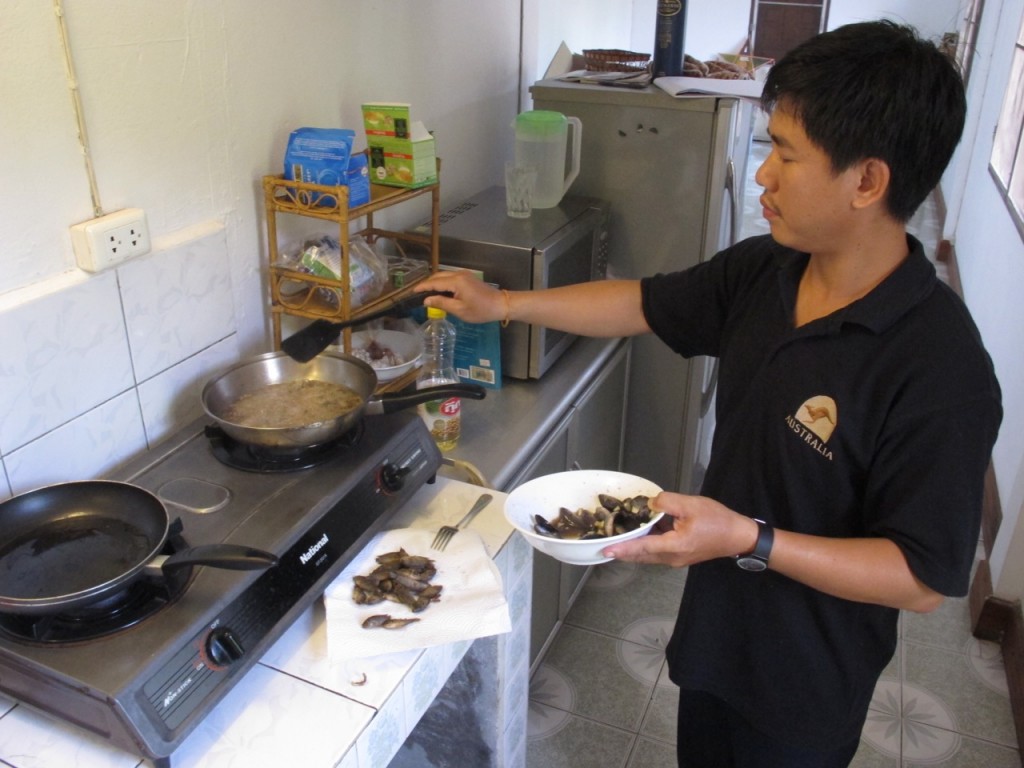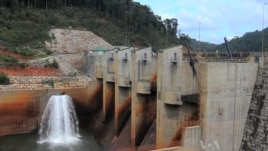|
|
The Zone Spilleth Over: Evaluating Fish Conservation Zones
|
|
|
|
March 31, 2014
Can protected areas for fish benefit both fish populations and fishing communities? This is a question we at FISHBIO have been investigating in Lao PDR, and address in a new report. In 2004, the World Wide Fund for Nature (WWF) officially established Fish Conservation Zones (FCZs) in the Nam Kading River, Central Lao PDR, as part of their Community Fisheries Program (ComFish). The goals of these no-fishing zones are to conserve aquatic biodiversity, as well as support community food security, household income, and sustainable livelihoods. ComFish has established more than 171 Fish Conservation Zones in the mainstream Mekong River and six major Mekong tributaries. WWF wanted to know whether two different FCZs in the Nam Kading actually benefited the fisheries of nearby communities. To answer this question FISHBIO worked with WWF, the Lao Department of Livestock and Fisheries, and local officials to develop a mark-recapture fish tagging study. The goal of the study was to evaluate the spillover contribution from the FCZs to fisher catches in nearby villages. 'Spillover' is the concept of fish increasing in abundance within a protected area then moving ('spilling') outside of the protected boundaries, where they can be caught by fishers. Protecting fish in an FCZ is like creating a fish savings account, and spillover is like the interest that can be withdrawn. This is a commonly cited benefit of fish protected areas; however, this concept has rarely been tested scientifically in Lao PDR. Our study found evidence to support the idea of spillover in Nam Kading, and a final report of the results is now available in English and Lao.
Before beginning the tagging effort, WWF conducted outreach in eight villages along the Nam Kading River to inform fishers about the study and encourage them to return tagged fish for a small reward. Members of the Lao Women's Union were trained to collect information about where and when tagged fish were recaptured (see Lao women in fish research). During the fish tagging effort, a total of 997 fish from 32 fish species were captured inside the two FCZs. Each fish was tagged with a t-bar anchor tag (often referred to as a "Floy" tag) printed with a unique ID number, and was returned to the river at the same site. The most common fish species caught and tagged inside the two FCZs were Amblyrhynchichthys truncatus (known as "pa mang" in Lao), Barbonymus schwanenfeldii ("pa vienfai"), and "pa pak," which includes several difficult-to-distinguish species from the genus Hypsibarbus.
After one year of participatory village research, local fishers recaptured and reported about 10% of the total tagged fish, representing eight fish species. Most fish were recaptured within 2 km of the FCZ where they were released, but the maximum distance for a recapture was 10.7 km. The two most abundant fishes in the tagging effort, "pa pak" and "pa mang," also dominated the recaptures, and had recapture rates of 14% and 10%, respectively. While "pa vienfai" made up a large proportion of the fish tagged inside the FCZ, only 3% of these fish were recaptured outside the FCZ. This low recapture rate may be due to the behavior of the fish (e.g., it has a small range and is unlikely to move outside of the FCZs), or may be because the species is unusually sensitive to handling and did not survive after tagging.
The results of this study show that at least eight species of fishes do move outside of FCZs, and this spillover can contribute to nearby fisheries (within at least 10 km). Because the fish tagging focused on a transitional period at the beginning of the rainy season, when many fish species are thought to migrate, it is possible that the fish captured for tagging were just briefly migrating through the FCZ and were not typical inhabitants of the habitat. The FCZ would still protect these migratory fish from fishers during their passage, but this would not constitute the typical definition of a "spillover effect," which is caused by the density of a fish population inside a reserve reaching capacity, and the adult fish 'spilling' out of the reserve. To clarify whether different fish species are remaining in the FCZ habitat or just passing through it, a more extensive study could be conducted to tag fishes over a longer period of time, with periodic surveys of the FCZs to estimate the number of tagged fish remaining inside. FISHBIO and WWF hope to continue investigating the dual role FCZs can play in protecting fish and sustaining fisheries and livelihoods.
|
|
 |
|
Recent Blog Posts
|
Crispy climbing perch 
Sinsamout, who works in our Lao PDR office, is our go-to culinary expert in all matters regarding Southeast Asian cuisine- especially tom yum soup (see No soup for you). Recently, he shared another dish with visiting staff at our Lao office - crispy climbing perch. The fish in question, Anabas testudineus, is known for its ability to survive out of water - and even crawl across land - thanks to an accessory breathing structure called a labyrinth organ. This folded wad of tissues lined with blood vessels is located above the gills, and allows the fish to breathe air it gulps down at the water surface. This enables the climbing perch to survive in brackish or stagnant waters, such as flooded fields or canals, which may be too oxygen-poor for other fishes. Lao women often catch these fishes in wetlands using lift nets (see Need a lift? ), as did the vendor that sold the fish to Sinsamout.  Although climbing perch can grow up to 25 cm (9.8 inches) long, Sinsamout had purchased a pile of juvenile fishes at a roadside market. In order to whip up a fried fish lunch snack, he first seasoned the bite-sized fish with chopped garlic, salt, soy sauce, and chili powder, then dropped them into a sizzling pan of hot oil (watch our new video to see the process in action). The result was a plateful of fried morsels that get crunched down whole - heads and tails, bones and scales and all. Although we initially had some reservations about eating whole fish, their predominant taste was fried crispiness rather than fishiness. According to Sinsamout, they make great snacks with ketchup and beer. It seems we've discovered the fishy Lao version of French fries... Read more...
|
|
|
|
IN THE NEWS: Recent stories you might have missed...
|
Tonle Sap Lake fisheries a concern for dam project
The Phnom Penh Post
Already under attack by overfishing, pollution and deforestation, Tonle Sap Lake fisheries face an even bigger threat in the form of hydropower dams, according to experts. Laos' planned Don Sahong Hydropower Project in particular has environmentalists fearing an emptier, less bio-diverse lake, and a nation pitched into protein shortages. "[The Don Sahong] is of particular concern because it will obstruct the only fish migration channel available... Read more >
|
Government calls for Laos to reexamine Mekong dam
Voice of America The Cambodian government on Thursday reiterated calls for Laos to reconsider the construction of a dam on the Mekong River that could have serious ecological and economic impacts on people living downstream. Environmental groups worry that the Don Sahong dam, to be built just upstream from Cambodia, could devastate fisheries that provide a major source of food for Cambodians living along the Mekong and Tonle Sap rivers... Read more >
|
Camus nears the end of epic Mekong adventure
The Phnom Penh Post

Solo adventurer Remi Camus is barely 300km away from completing an incredible 4,400km riverboarding expedition down the Mekong River, from its origin in Tibet to the point in Vietnam where it joins the South China Sea. The 28-year-old Frenchman is currently in Phnom Penh and will take the final plunge on Friday morning towards Vietnam to end in early April his charity mission of raising awareness and funds for safe drinking water in the six countries... Read more >
|
Truckin': Salmon take a long, strange trip to the Pacific Ocean
NPR
 California, severe drought has imperiled millions of juvenile salmon who now face waterways too dry to let them make their usual migration to the Pacific Ocean. So state and federal officials are giving millions of salmon a lift - in tanker trucks. Over the next two-and-a-half months, some 30 million Chinook salmon will be trucked from five hatcheries in the state's Central Valley to waters where they can make their way to the ocean... Read more > California, severe drought has imperiled millions of juvenile salmon who now face waterways too dry to let them make their usual migration to the Pacific Ocean. So state and federal officials are giving millions of salmon a lift - in tanker trucks. Over the next two-and-a-half months, some 30 million Chinook salmon will be trucked from five hatcheries in the state's Central Valley to waters where they can make their way to the ocean... Read more >
|
Fish-eating birds to be killed at 5 dams
Daily Astorian

Operators of five dams on the Columbia and lower Snake rivers will start killing birds that eat migrating juvenile salmon. The measures are meant to protect endangered salmon and steelhead as they begin their journey out to sea. This is the first time in 20 years that dam managers say they have had to kill what they call nuisance birds at the dams. "Research studies have shown that the fish-eating birds consume significant numbers of juvenile salmon and steelhead at the dams,..." Read more >
|
|
|
|
|
|